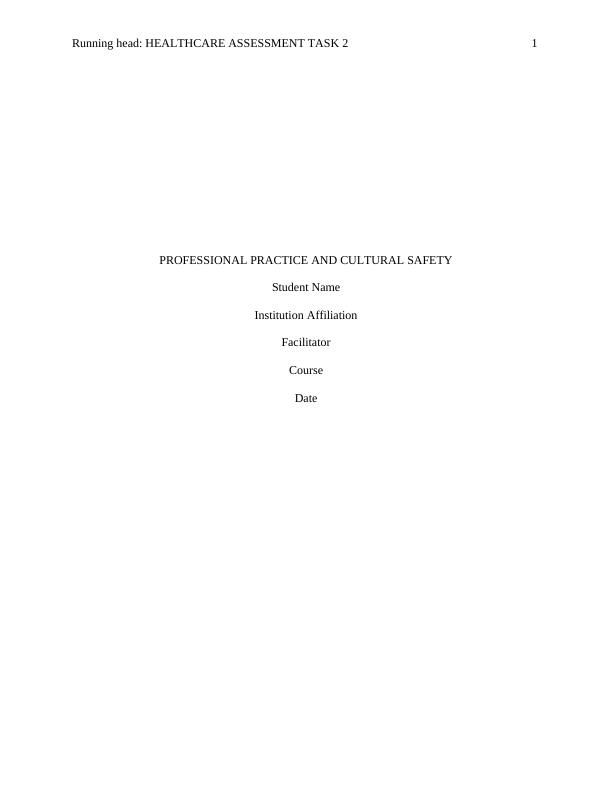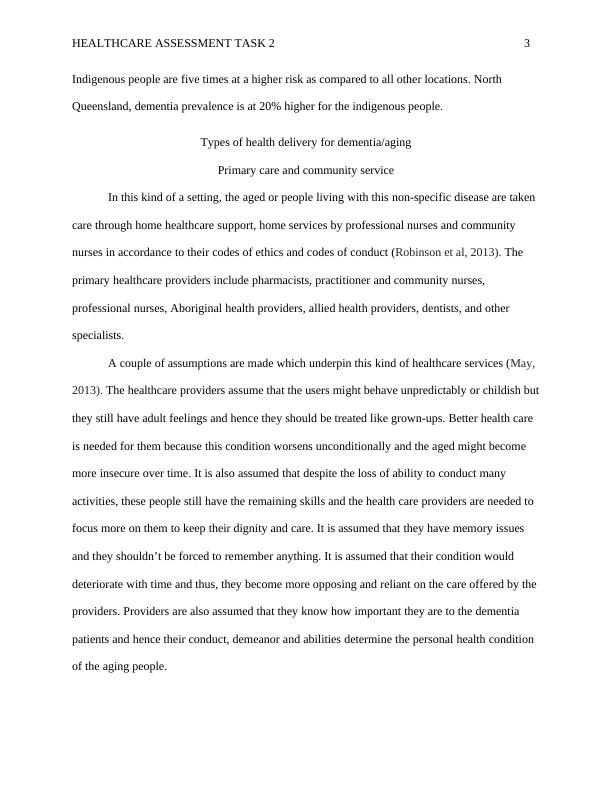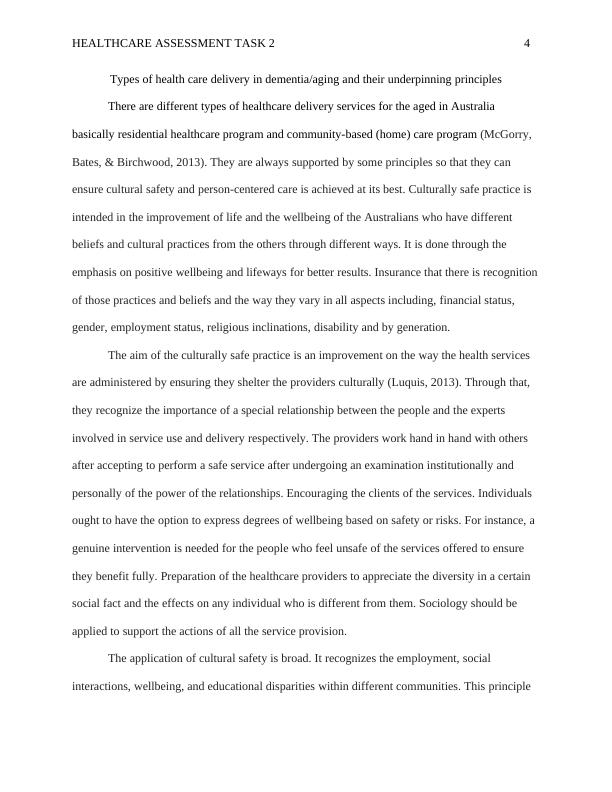Dementia and Aging: Types of Health Delivery, Impacts of Poverty, and Discrimination in Healthcare
Added on 2022-11-25
11 Pages3215 Words351 Views
Running head: HEALTHCARE ASSESSMENT TASK 2 1
PROFESSIONAL PRACTICE AND CULTURAL SAFETY
Student Name
Institution Affiliation
Facilitator
Course
Date
PROFESSIONAL PRACTICE AND CULTURAL SAFETY
Student Name
Institution Affiliation
Facilitator
Course
Date

HEALTHCARE ASSESSMENT TASK 2 2
DEMENTIA/AGING
Introduction
Dementia is a health condition where the affected people lose cognitive functioning like
memory, thinking and the ability to reason properly (Alzheimer's Association, 2014). These
people can also be affected in terms of behavioral abilities such that they can’t perform their
daily activities as expected of them. Some of the functions which are reduced include language
skills, qualitative problem solving, focus, paying attention, visual perception and personal
management among other personal activities.
In Australia, dementia is termed as the second leading cause of death. Dementia causes
approximately 17 percent of deaths annually. 5.8% of the total deaths are men and 11.3% are
women (Thomson et al, 2014). Australia Institute of Health and Welfare statistically suggests
that above 400,000 people are living with this condition of dementia. The number of people
joining this condition on a daily basis has increased from 250 to 318 and this suggests that by
2028 more than 500,000 people will be having dementia. Among the 55% of these people are
women. In the aged health care facilities, 50% of the people are living with dementia (Moyle,
Murfield, Griffiths, &Venturato, 2012).
Chances are that this condition is more prevalent among the aged than young people. It is
evident that every 10 people above 85 years of age three are affected and among every 10 people
above 65 years of age 1 person is affected (Gurgel et al, 2014). Between the range of 45 years to
65 years only 1 person among 100 is affected. Below the age of 45, it is said that about 1 person
in a population of 1000 is affected. Dementia is more prevalent among people of lower social
class than that of the higher social class (Lund et al, 2010). In Australia, the most marginalized
groups like Indigenous people are at a higher risk as compared to other groups. Kimberly
DEMENTIA/AGING
Introduction
Dementia is a health condition where the affected people lose cognitive functioning like
memory, thinking and the ability to reason properly (Alzheimer's Association, 2014). These
people can also be affected in terms of behavioral abilities such that they can’t perform their
daily activities as expected of them. Some of the functions which are reduced include language
skills, qualitative problem solving, focus, paying attention, visual perception and personal
management among other personal activities.
In Australia, dementia is termed as the second leading cause of death. Dementia causes
approximately 17 percent of deaths annually. 5.8% of the total deaths are men and 11.3% are
women (Thomson et al, 2014). Australia Institute of Health and Welfare statistically suggests
that above 400,000 people are living with this condition of dementia. The number of people
joining this condition on a daily basis has increased from 250 to 318 and this suggests that by
2028 more than 500,000 people will be having dementia. Among the 55% of these people are
women. In the aged health care facilities, 50% of the people are living with dementia (Moyle,
Murfield, Griffiths, &Venturato, 2012).
Chances are that this condition is more prevalent among the aged than young people. It is
evident that every 10 people above 85 years of age three are affected and among every 10 people
above 65 years of age 1 person is affected (Gurgel et al, 2014). Between the range of 45 years to
65 years only 1 person among 100 is affected. Below the age of 45, it is said that about 1 person
in a population of 1000 is affected. Dementia is more prevalent among people of lower social
class than that of the higher social class (Lund et al, 2010). In Australia, the most marginalized
groups like Indigenous people are at a higher risk as compared to other groups. Kimberly

HEALTHCARE ASSESSMENT TASK 2 3
Indigenous people are five times at a higher risk as compared to all other locations. North
Queensland, dementia prevalence is at 20% higher for the indigenous people.
Types of health delivery for dementia/aging
Primary care and community service
In this kind of a setting, the aged or people living with this non-specific disease are taken
care through home healthcare support, home services by professional nurses and community
nurses in accordance to their codes of ethics and codes of conduct (Robinson et al, 2013). The
primary healthcare providers include pharmacists, practitioner and community nurses,
professional nurses, Aboriginal health providers, allied health providers, dentists, and other
specialists.
A couple of assumptions are made which underpin this kind of healthcare services (May,
2013). The healthcare providers assume that the users might behave unpredictably or childish but
they still have adult feelings and hence they should be treated like grown-ups. Better health care
is needed for them because this condition worsens unconditionally and the aged might become
more insecure over time. It is also assumed that despite the loss of ability to conduct many
activities, these people still have the remaining skills and the health care providers are needed to
focus more on them to keep their dignity and care. It is assumed that they have memory issues
and they shouldn’t be forced to remember anything. It is assumed that their condition would
deteriorate with time and thus, they become more opposing and reliant on the care offered by the
providers. Providers are also assumed that they know how important they are to the dementia
patients and hence their conduct, demeanor and abilities determine the personal health condition
of the aging people.
Indigenous people are five times at a higher risk as compared to all other locations. North
Queensland, dementia prevalence is at 20% higher for the indigenous people.
Types of health delivery for dementia/aging
Primary care and community service
In this kind of a setting, the aged or people living with this non-specific disease are taken
care through home healthcare support, home services by professional nurses and community
nurses in accordance to their codes of ethics and codes of conduct (Robinson et al, 2013). The
primary healthcare providers include pharmacists, practitioner and community nurses,
professional nurses, Aboriginal health providers, allied health providers, dentists, and other
specialists.
A couple of assumptions are made which underpin this kind of healthcare services (May,
2013). The healthcare providers assume that the users might behave unpredictably or childish but
they still have adult feelings and hence they should be treated like grown-ups. Better health care
is needed for them because this condition worsens unconditionally and the aged might become
more insecure over time. It is also assumed that despite the loss of ability to conduct many
activities, these people still have the remaining skills and the health care providers are needed to
focus more on them to keep their dignity and care. It is assumed that they have memory issues
and they shouldn’t be forced to remember anything. It is assumed that their condition would
deteriorate with time and thus, they become more opposing and reliant on the care offered by the
providers. Providers are also assumed that they know how important they are to the dementia
patients and hence their conduct, demeanor and abilities determine the personal health condition
of the aging people.

HEALTHCARE ASSESSMENT TASK 2 4
Types of health care delivery in dementia/aging and their underpinning principles
There are different types of healthcare delivery services for the aged in Australia
basically residential healthcare program and community-based (home) care program (McGorry,
Bates, & Birchwood, 2013). They are always supported by some principles so that they can
ensure cultural safety and person-centered care is achieved at its best. Culturally safe practice is
intended in the improvement of life and the wellbeing of the Australians who have different
beliefs and cultural practices from the others through different ways. It is done through the
emphasis on positive wellbeing and lifeways for better results. Insurance that there is recognition
of those practices and beliefs and the way they vary in all aspects including, financial status,
gender, employment status, religious inclinations, disability and by generation.
The aim of the culturally safe practice is an improvement on the way the health services
are administered by ensuring they shelter the providers culturally (Luquis, 2013). Through that,
they recognize the importance of a special relationship between the people and the experts
involved in service use and delivery respectively. The providers work hand in hand with others
after accepting to perform a safe service after undergoing an examination institutionally and
personally of the power of the relationships. Encouraging the clients of the services. Individuals
ought to have the option to express degrees of wellbeing based on safety or risks. For instance, a
genuine intervention is needed for the people who feel unsafe of the services offered to ensure
they benefit fully. Preparation of the healthcare providers to appreciate the diversity in a certain
social fact and the effects on any individual who is different from them. Sociology should be
applied to support the actions of all the service provision.
The application of cultural safety is broad. It recognizes the employment, social
interactions, wellbeing, and educational disparities within different communities. This principle
Types of health care delivery in dementia/aging and their underpinning principles
There are different types of healthcare delivery services for the aged in Australia
basically residential healthcare program and community-based (home) care program (McGorry,
Bates, & Birchwood, 2013). They are always supported by some principles so that they can
ensure cultural safety and person-centered care is achieved at its best. Culturally safe practice is
intended in the improvement of life and the wellbeing of the Australians who have different
beliefs and cultural practices from the others through different ways. It is done through the
emphasis on positive wellbeing and lifeways for better results. Insurance that there is recognition
of those practices and beliefs and the way they vary in all aspects including, financial status,
gender, employment status, religious inclinations, disability and by generation.
The aim of the culturally safe practice is an improvement on the way the health services
are administered by ensuring they shelter the providers culturally (Luquis, 2013). Through that,
they recognize the importance of a special relationship between the people and the experts
involved in service use and delivery respectively. The providers work hand in hand with others
after accepting to perform a safe service after undergoing an examination institutionally and
personally of the power of the relationships. Encouraging the clients of the services. Individuals
ought to have the option to express degrees of wellbeing based on safety or risks. For instance, a
genuine intervention is needed for the people who feel unsafe of the services offered to ensure
they benefit fully. Preparation of the healthcare providers to appreciate the diversity in a certain
social fact and the effects on any individual who is different from them. Sociology should be
applied to support the actions of all the service provision.
The application of cultural safety is broad. It recognizes the employment, social
interactions, wellbeing, and educational disparities within different communities. This principle

End of preview
Want to access all the pages? Upload your documents or become a member.
Related Documents
Dementia and Aging: Types of Health Delivery and Impacts of Povertylg...
|11
|3319
|23
Approach to Dementia Care Practice Improvementlg...
|5
|1026
|23
Health Care Delivery Methods in Dementia and Impact of Povertylg...
|11
|2841
|165
Australian Government Department of Healthlg...
|10
|2403
|20
Professional Practice and Cultural Safetylg...
|12
|3481
|36
NURBN2008 - Nursing Dementia Patient : Essaylg...
|14
|3885
|913
